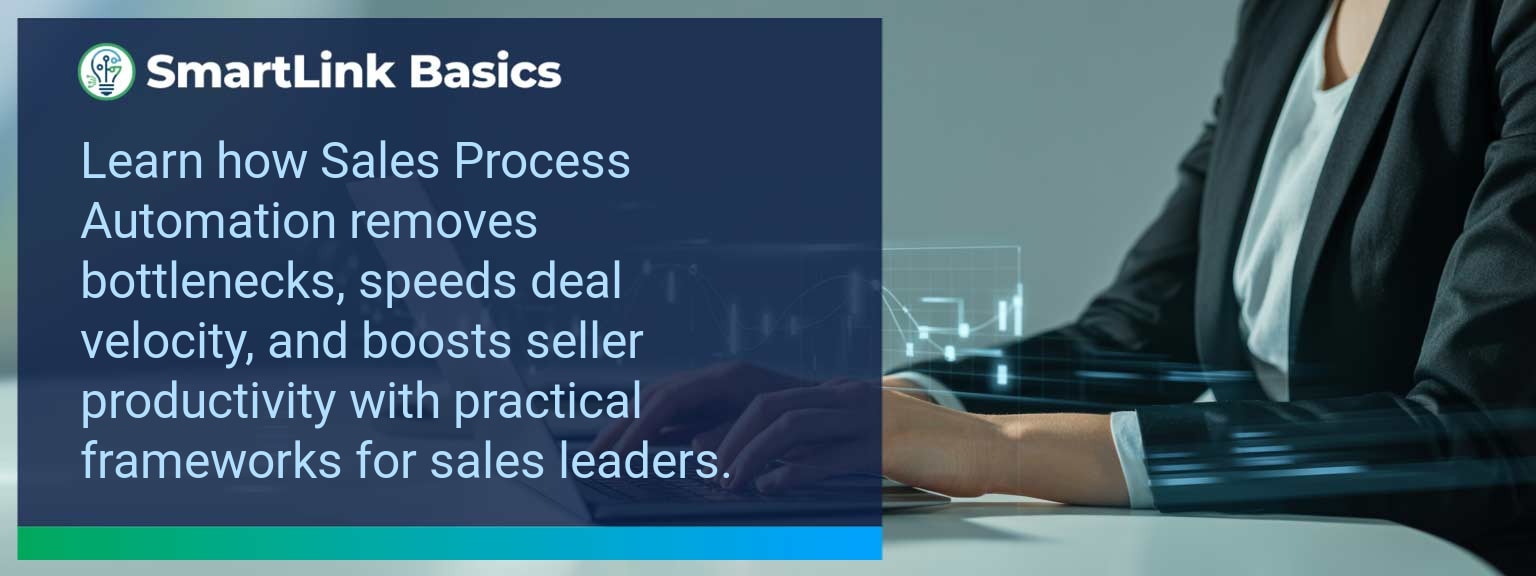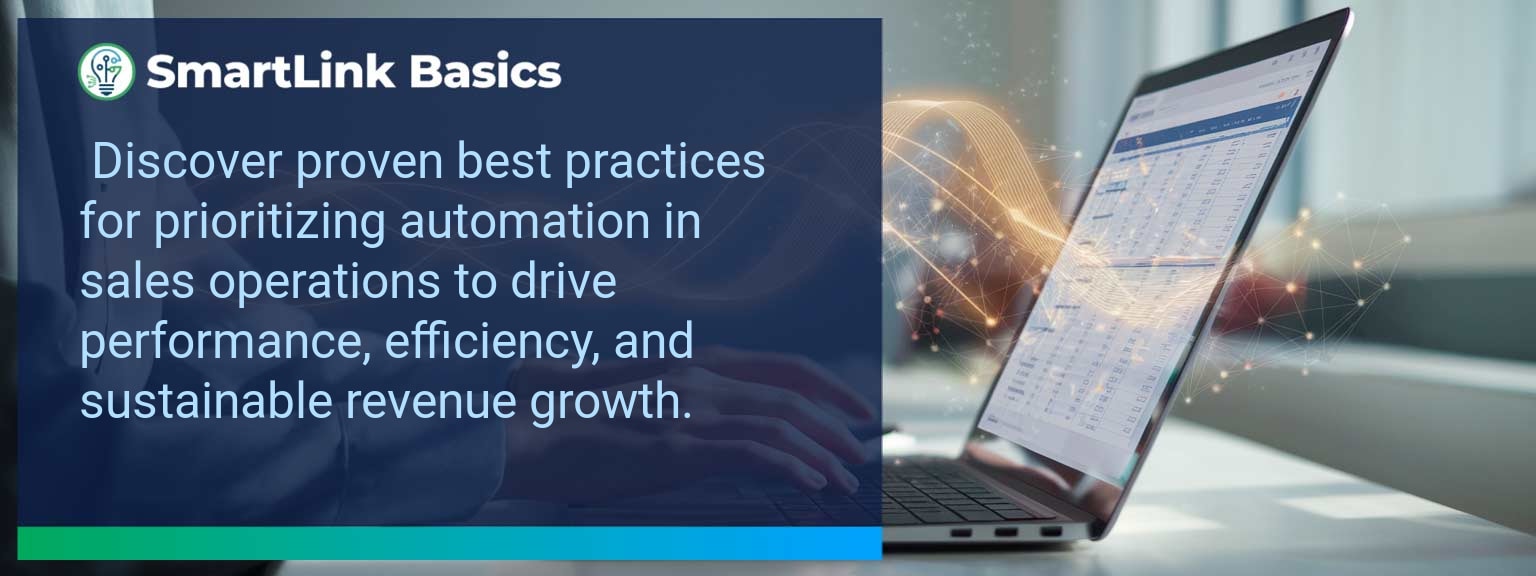Industry data shows that organizations adopting AI-driven automation achieve cost reductions of up to 30% while accelerating sales cycles by 20% or more (McKinsey, 2024). For sales leaders, AI automated workflows now define competitive advantage, enabling teams to reallocate time from repetitive tasks to high-value engagements. At SmartLink Basics, we help decision-makers implement these systems strategically, ensuring they integrate with existing revenue operations. In this article, you’ll see how AI automated workflows power business outcomes, the common obstacles that slow adoption, and practical steps to optimize processes. You’ll walk away with proven examples, a 90-day action blueprint, and measurable KPIs to track results.
- Automate repetitive administrative and CRM updates with AI.
- Integrate machine learning to personalize outreach at scale.
- Streamline approvals, quotes, and contract workflows for speed.
- Use predictive analytics to prioritize sales opportunities.
- Track adoption and performance with targeted metrics.
AI Automated Workflows: What Changed and Why It Matters
AI adoption has shifted from experimental to operational, making automated workflows a standard in high-performing sales organizations. The real advantage lies in combining workflow automation with artificial intelligence workflows to optimize every step of the revenue process. Sales leaders now use AI to synchronize touchpoints, reduce manual inputs, and ensure faster execution. For example, a B2B SaaS leader introduced automated lead enrichment and routing, cutting qualification time by 60%. Actionable insight: Audit processes for time-intensive handoffs and apply AI where repeatability is high.Redesign the Revenue Operating System With AI Automated Workflows
ICP, Segmentation, and Targeting AI-enabled segmentation uses historical wins, firmographic, and behavioral data to dynamically update ICP profiles. This ensures targeting precision without quarterly re-work. Pipeline Architecture Automated workflows push opportunities through the right stages based on engagement signals. AI flags at-risk deals for intervention. Plays and Messaging Integrated automation tools deliver personalized sequences based on buyer activity, increasing relevance at every touchpoint. Operating Cadence AI schedules follow-ups, forecast calls, and account reviews based on actual pipeline movement rather than static calendars. Actionable insight: Implement automation that adapts in real-time to both internal and buyer-driven events.Common Obstacles To Achieving Seamless Automation
The most frequent challenges are fragmented systems, inconsistent data quality, and cultural resistance. Without a unified data layer, automation amplifies errors rather than solving them. Coca-Cola Europacific Partners reported needing a full data governance upgrade before AI could improve sales workflows. Leaders must first assess infrastructure readiness and train teams to trust AI-influenced recommendations. Actionable insight: Before deployment, establish clean data practices and a single source of truth.Implementing AI To Optimize Workflows
Effective deployment of AI process optimization starts with mapping current-state processes, identifying friction points, and matching them with automation tools. For example, automating proposal generation based on CRM opportunity data can reduce turnaround from three days to one hour. Solutions combining business process automation platforms with machine learning integration enable continuous performance improvement. Actionable insight: Pilot in one high-impact stage, measure, and then expand.Tangible Benefits From Automated Processes
The benefits extend beyond time savings — sales leaders gain a scalable system. Tangible outcomes include faster quote-to-close, higher lead conversion, and better forecast accuracy. A manufacturing firm implemented AI-assisted order processing and cut errors by 40%, improving on-time delivery rates. Actionable insight: Track both speed and accuracy to measure workflow automation effectiveness.Metrics That Matter
| Category | Metric | Definition | Target |
|---|---|---|---|
| Leading | Workflow Completion Rate | % of automated sequences executed without manual intervention | 95%+ |
| Leading | AI Suggestion Adoption Rate | % of AI-generated action recommendations executed by reps | 80%+ |
| Lagging | Cycle Time Reduction | Decrease in time from lead entry to closed-won | 20%+ |
| Lagging | Revenue Per Rep | Average sales revenue generated per sales rep per quarter | +15% YoY |
| Quality | Automation Error Rate | % of workflows that trigger incorrect outcomes | <1% |
| Quality | Customer Satisfaction Post-Automation | Average CSAT score after automation implementation | ≥ 4.5/5 |
Innovations And Next Steps For AI Automation
Emerging capabilities like AI-generated playbooks, intent-driven dynamic routing, and integrated AR for virtual product demos are shaping the next wave of sales automation. Companies integrating these tools early will outpace competitors in speed and personalization. Actionable insight: Stay ahead by testing emerging automation features quarterly and aligning them with evolving buyer expectations.Get the 90-day plan, coaching rubric, and dashboard template to operationalize AI in your enablement program.
Turning AI Automation Into a Revenue Multiplier
AI automated workflows are now a strategic lever for predictable, scalable growth. This guide outlined current applications, adoption challenges, a 90-day execution plan, and measurable success criteria. To make automation pay off, sales leaders should integrate tools into one cohesive operating system and review results monthly for continuous improvement. Access more AI-driven sales enablement resources from SmartLink Basics to design a high-performance automation strategy. Sales organizations that thrive in shifting markets have one essential advantage: agile leadership that adjusts quickly without losing momentum. At SmartLink Basics, we have seen that successful sales leadership strategies go beyond setting targets—they create adaptable systems, foster collaboration, and maintain consistent performance improvement. This matters because unpredictable customer behavior, evolving buyer expectations, and competitive disruption demand teams that can pivot without chaos. In this article, you will learn how to redesign your sales operation for agility, implement leadership practices that elevate responsiveness, and measure the impact through performance gains.- Define clear agile leadership principles for your sales team.
- Redesign pipeline architecture for faster, informed decisions.
- Embed collaboration practices into operating cadence.
- Use data-driven performance coaching for continuous improvement.
- Measure impact through leading, lagging, and quality metrics.
What Changed And Why It Matters Now For Sales Leadership Strategies
Sales cycles are shorter, yet decisions often take longer. Customer expectations move quickly, and rigid leadership models slow down response times. Agile sales teams, led by informed and empowered managers, can change tactics without losing alignment. This requires leadership that designs processes for speed, implements clear collaboration protocols, and uses performance data as a decision driver. An example is a technology company that shifted from quarterly to monthly sales planning, enabling them to reprioritize prospects based on market signals, resulting in a faster win rate recovery during a competitive threat. Agile sales leadership means managing not just activity but adaptability. Leaders must set clear rules for decision-making, train teams in those principles, and revisit them regularly to maintain performance resilience.Redesign The Revenue Operating System With Sales Leadership Strategies
Redesigning the operating system your team uses every day is critical for building agile sales teams. Four focus areas determine whether changes take root and deliver results. ICP, Segmentation, and Targeting Define the ideal customer profile using hard performance data, not assumptions. Focus targeting efforts where conversion potential is highest, then align messaging accordingly. Pipeline Architecture Build a structure that supports rapid qualification and exit of low-probability deals. Use CRM automation to flag risk and opportunity signals in real-time. Plays and Messaging Standardize core plays for high-frequency scenarios but allow field adjustments based on customer interaction data. Provide updated messaging playbooks to avoid lag between market changes and sales execution. Operating Cadence Set short-cycle review meetings to evaluate both performance and market shifts. This ensures ongoing alignment between leadership direction and field execution.Common Obstacles Facing Sales Leaders
Even experienced leaders face resistance when shifting from static to agile sales management models. Common obstacles include misaligned incentives, overcomplicated processes, and inadequate data visibility. Each of these hampers quick decision-making. For instance, incentive plans that only reward closed deals may discourage reps from reallocating effort to emerging high-potential accounts. Leaders must reframe success metrics to promote adaptability. Countering these obstacles requires both short-term fixes—like streamlined deal review protocols—and systemic changes to reinforcement, such as ongoing performance improvement frameworks.Proven Strategies For Building Agile Teams
Agile sales leadership combines structured systems with freedom to adapt. Begin with collaborative planning that aligns goals across sales, marketing, and operations. Use agile sprint-style frameworks for tactical execution, allowing adjustments every 30–45 days. Sales coaching becomes more impactful when it focuses on skills that directly affect win probability and sales growth potential. Documenting lessons from both wins and losses ensures collective team improvement. Example: A manufacturing company introduced a rolling 45-day training calendar tied to market conditions, enabling frontline teams to respond faster to competitive pricing moves.Measurable Gains From Strong Leadership
Agile leadership, when effectively implemented, produces performance improvement visible across multiple indicators. Increased conversion rates, shorter sales cycles, and stronger forecast accuracy are common results. The following table shows key metrics to track:| Category | Metric | Definition | Target |
|---|---|---|---|
| Leading | Pipeline Velocity | Speed at which deals move through the pipeline | Increase by 15% in 90 days |
| Lagging | Quota Attainment | % of reps hitting sales targets | 85%+ |
| Quality | Win Rate | % of qualified deals won | Over 40% |
Preparing Teams For Tomorrow’s Market
Tomorrow’s sales market will reward speed and insight over sheer activity volume. Teams prepared for this shift will continually refine their ideal customer profile and expand collaboration with cross-functional partners. Scenario-based planning and proactive skills development will position sales teams to act ahead of competitors. Integrating leadership development programs into the sales function ensures agility becomes part of the culture, not just a response mechanism.Get the 90-day plan, coaching rubric, and dashboard template to operationalize AI in your enablement program.









